Unconscious Phantasy and its Conceptualizations: An Attempt at Conceptual Integration
VerifiedAdded on 2022/10/12
|5
|1064
|152
AI Summary
This article discusses the concept of unconscious phantasy and its conceptualizations in psychoanalytic theory and practice. It also explores the different forms of unconscious phantasy and their impact on the emotional aspects of the transference relationship.
Contribute Materials
Your contribution can guide someone’s learning journey. Share your
documents today.
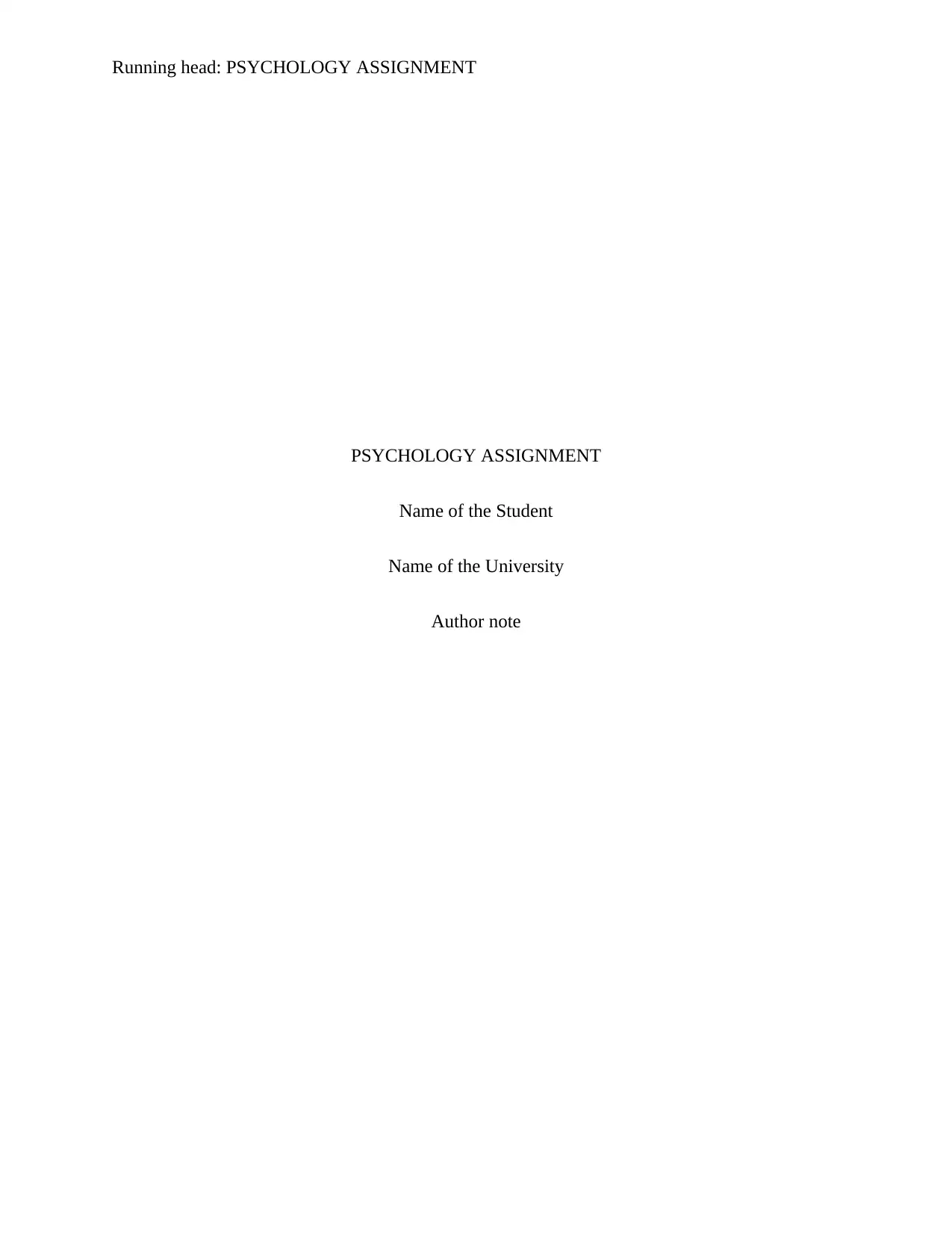
Running head: PSYCHOLOGY ASSIGNMENT
PSYCHOLOGY ASSIGNMENT
Name of the Student
Name of the University
Author note
PSYCHOLOGY ASSIGNMENT
Name of the Student
Name of the University
Author note
Secure Best Marks with AI Grader
Need help grading? Try our AI Grader for instant feedback on your assignments.
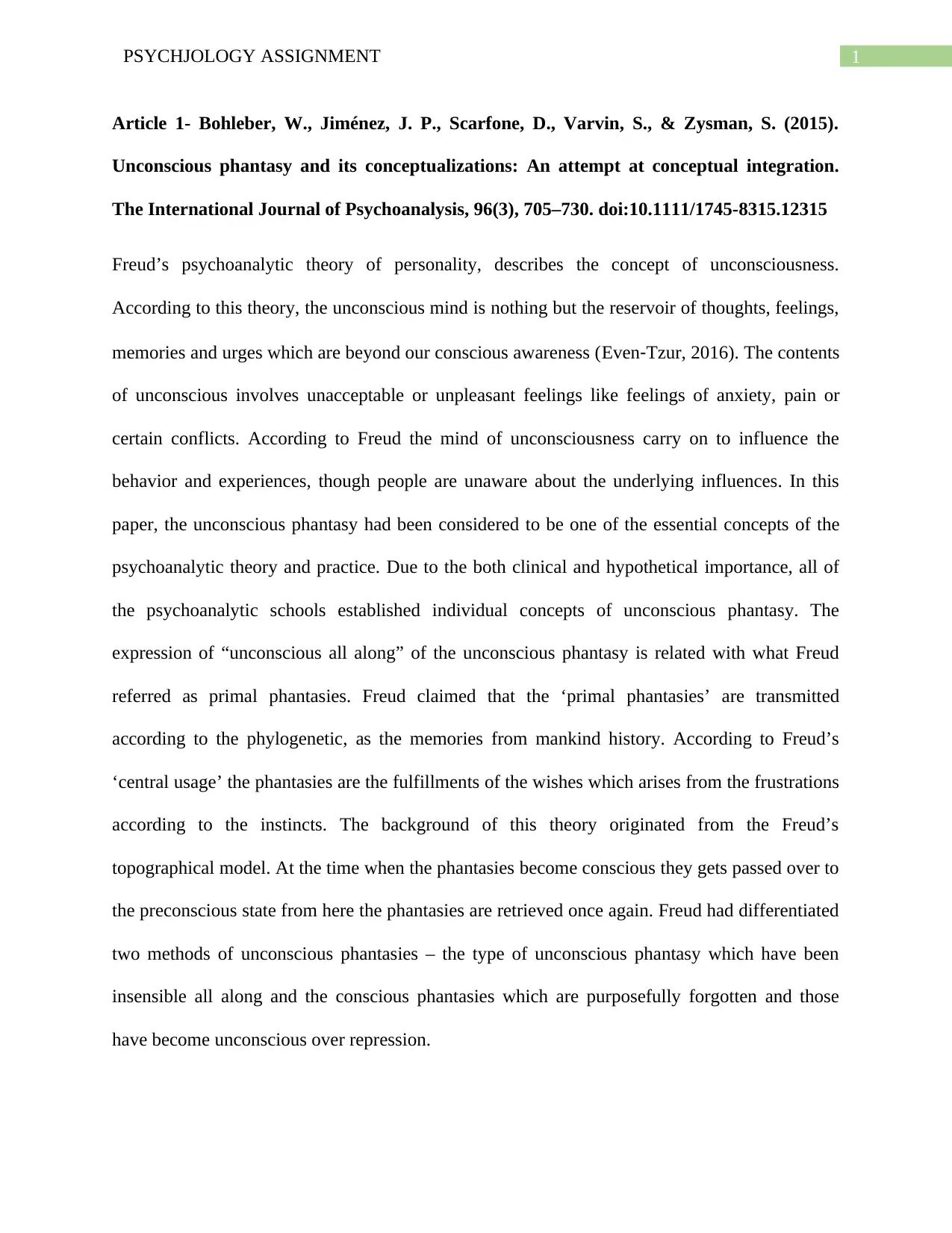
1PSYCHJOLOGY ASSIGNMENT
Article 1- Bohleber, W., Jiménez, J. P., Scarfone, D., Varvin, S., & Zysman, S. (2015).
Unconscious phantasy and its conceptualizations: An attempt at conceptual integration.
The International Journal of Psychoanalysis, 96(3), 705–730. doi:10.1111/1745-8315.12315
Freud’s psychoanalytic theory of personality, describes the concept of unconsciousness.
According to this theory, the unconscious mind is nothing but the reservoir of thoughts, feelings,
memories and urges which are beyond our conscious awareness (Even‐Tzur, 2016). The contents
of unconscious involves unacceptable or unpleasant feelings like feelings of anxiety, pain or
certain conflicts. According to Freud the mind of unconsciousness carry on to influence the
behavior and experiences, though people are unaware about the underlying influences. In this
paper, the unconscious phantasy had been considered to be one of the essential concepts of the
psychoanalytic theory and practice. Due to the both clinical and hypothetical importance, all of
the psychoanalytic schools established individual concepts of unconscious phantasy. The
expression of “unconscious all along” of the unconscious phantasy is related with what Freud
referred as primal phantasies. Freud claimed that the ‘primal phantasies’ are transmitted
according to the phylogenetic, as the memories from mankind history. According to Freud’s
‘central usage’ the phantasies are the fulfillments of the wishes which arises from the frustrations
according to the instincts. The background of this theory originated from the Freud’s
topographical model. At the time when the phantasies become conscious they gets passed over to
the preconscious state from here the phantasies are retrieved once again. Freud had differentiated
two methods of unconscious phantasies – the type of unconscious phantasy which have been
insensible all along and the conscious phantasies which are purposefully forgotten and those
have become unconscious over repression.
Article 1- Bohleber, W., Jiménez, J. P., Scarfone, D., Varvin, S., & Zysman, S. (2015).
Unconscious phantasy and its conceptualizations: An attempt at conceptual integration.
The International Journal of Psychoanalysis, 96(3), 705–730. doi:10.1111/1745-8315.12315
Freud’s psychoanalytic theory of personality, describes the concept of unconsciousness.
According to this theory, the unconscious mind is nothing but the reservoir of thoughts, feelings,
memories and urges which are beyond our conscious awareness (Even‐Tzur, 2016). The contents
of unconscious involves unacceptable or unpleasant feelings like feelings of anxiety, pain or
certain conflicts. According to Freud the mind of unconsciousness carry on to influence the
behavior and experiences, though people are unaware about the underlying influences. In this
paper, the unconscious phantasy had been considered to be one of the essential concepts of the
psychoanalytic theory and practice. Due to the both clinical and hypothetical importance, all of
the psychoanalytic schools established individual concepts of unconscious phantasy. The
expression of “unconscious all along” of the unconscious phantasy is related with what Freud
referred as primal phantasies. Freud claimed that the ‘primal phantasies’ are transmitted
according to the phylogenetic, as the memories from mankind history. According to Freud’s
‘central usage’ the phantasies are the fulfillments of the wishes which arises from the frustrations
according to the instincts. The background of this theory originated from the Freud’s
topographical model. At the time when the phantasies become conscious they gets passed over to
the preconscious state from here the phantasies are retrieved once again. Freud had differentiated
two methods of unconscious phantasies – the type of unconscious phantasy which have been
insensible all along and the conscious phantasies which are purposefully forgotten and those
have become unconscious over repression.
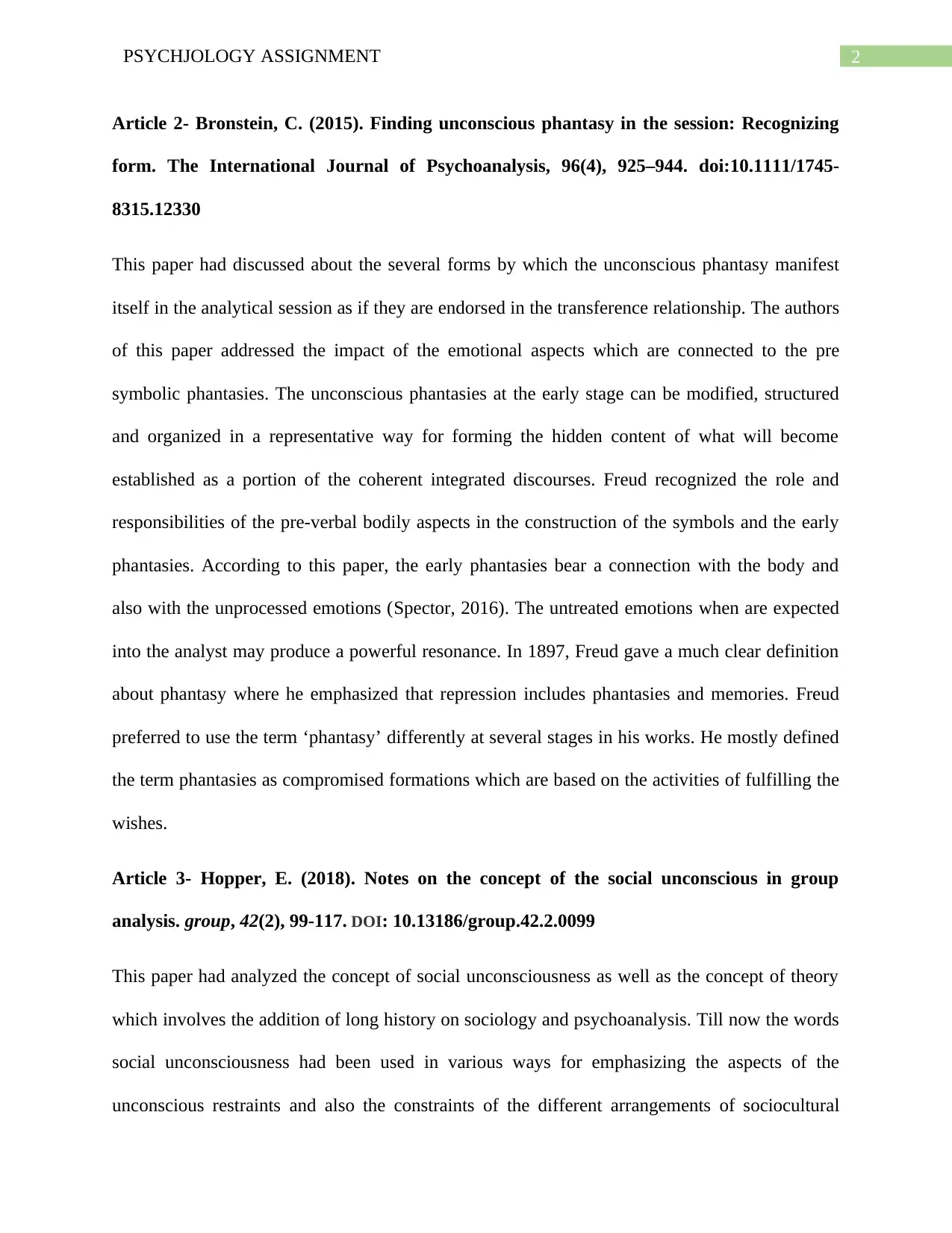
2PSYCHJOLOGY ASSIGNMENT
Article 2- Bronstein, C. (2015). Finding unconscious phantasy in the session: Recognizing
form. The International Journal of Psychoanalysis, 96(4), 925–944. doi:10.1111/1745-
8315.12330
This paper had discussed about the several forms by which the unconscious phantasy manifest
itself in the analytical session as if they are endorsed in the transference relationship. The authors
of this paper addressed the impact of the emotional aspects which are connected to the pre
symbolic phantasies. The unconscious phantasies at the early stage can be modified, structured
and organized in a representative way for forming the hidden content of what will become
established as a portion of the coherent integrated discourses. Freud recognized the role and
responsibilities of the pre-verbal bodily aspects in the construction of the symbols and the early
phantasies. According to this paper, the early phantasies bear a connection with the body and
also with the unprocessed emotions (Spector, 2016). The untreated emotions when are expected
into the analyst may produce a powerful resonance. In 1897, Freud gave a much clear definition
about phantasy where he emphasized that repression includes phantasies and memories. Freud
preferred to use the term ‘phantasy’ differently at several stages in his works. He mostly defined
the term phantasies as compromised formations which are based on the activities of fulfilling the
wishes.
Article 3- Hopper, E. (2018). Notes on the concept of the social unconscious in group
analysis. group, 42(2), 99-117. DOI: 10.13186/group.42.2.0099
This paper had analyzed the concept of social unconsciousness as well as the concept of theory
which involves the addition of long history on sociology and psychoanalysis. Till now the words
social unconsciousness had been used in various ways for emphasizing the aspects of the
unconscious restraints and also the constraints of the different arrangements of sociocultural
Article 2- Bronstein, C. (2015). Finding unconscious phantasy in the session: Recognizing
form. The International Journal of Psychoanalysis, 96(4), 925–944. doi:10.1111/1745-
8315.12330
This paper had discussed about the several forms by which the unconscious phantasy manifest
itself in the analytical session as if they are endorsed in the transference relationship. The authors
of this paper addressed the impact of the emotional aspects which are connected to the pre
symbolic phantasies. The unconscious phantasies at the early stage can be modified, structured
and organized in a representative way for forming the hidden content of what will become
established as a portion of the coherent integrated discourses. Freud recognized the role and
responsibilities of the pre-verbal bodily aspects in the construction of the symbols and the early
phantasies. According to this paper, the early phantasies bear a connection with the body and
also with the unprocessed emotions (Spector, 2016). The untreated emotions when are expected
into the analyst may produce a powerful resonance. In 1897, Freud gave a much clear definition
about phantasy where he emphasized that repression includes phantasies and memories. Freud
preferred to use the term ‘phantasy’ differently at several stages in his works. He mostly defined
the term phantasies as compromised formations which are based on the activities of fulfilling the
wishes.
Article 3- Hopper, E. (2018). Notes on the concept of the social unconscious in group
analysis. group, 42(2), 99-117. DOI: 10.13186/group.42.2.0099
This paper had analyzed the concept of social unconsciousness as well as the concept of theory
which involves the addition of long history on sociology and psychoanalysis. Till now the words
social unconsciousness had been used in various ways for emphasizing the aspects of the
unconscious restraints and also the constraints of the different arrangements of sociocultural
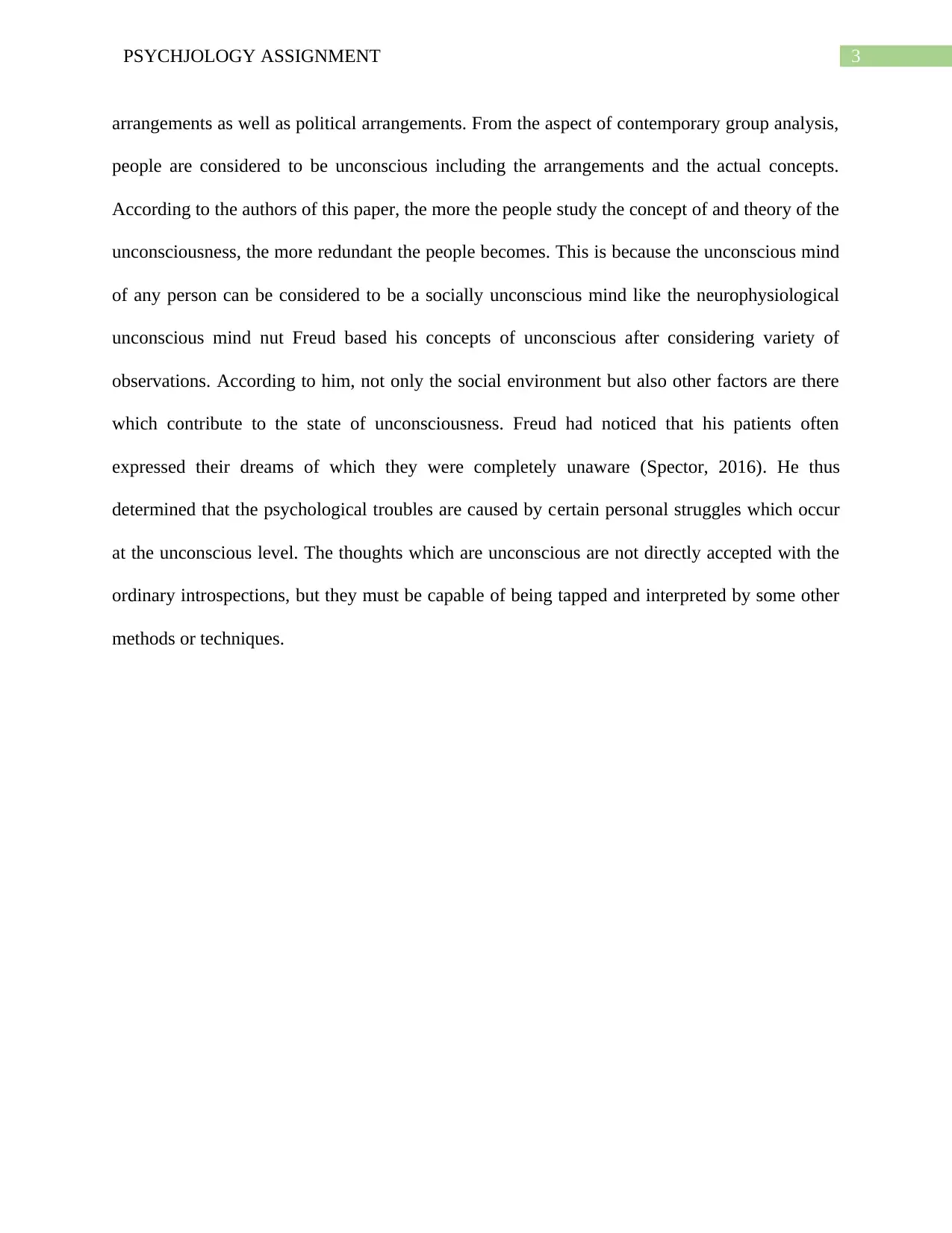
3PSYCHJOLOGY ASSIGNMENT
arrangements as well as political arrangements. From the aspect of contemporary group analysis,
people are considered to be unconscious including the arrangements and the actual concepts.
According to the authors of this paper, the more the people study the concept of and theory of the
unconsciousness, the more redundant the people becomes. This is because the unconscious mind
of any person can be considered to be a socially unconscious mind like the neurophysiological
unconscious mind nut Freud based his concepts of unconscious after considering variety of
observations. According to him, not only the social environment but also other factors are there
which contribute to the state of unconsciousness. Freud had noticed that his patients often
expressed their dreams of which they were completely unaware (Spector, 2016). He thus
determined that the psychological troubles are caused by certain personal struggles which occur
at the unconscious level. The thoughts which are unconscious are not directly accepted with the
ordinary introspections, but they must be capable of being tapped and interpreted by some other
methods or techniques.
arrangements as well as political arrangements. From the aspect of contemporary group analysis,
people are considered to be unconscious including the arrangements and the actual concepts.
According to the authors of this paper, the more the people study the concept of and theory of the
unconsciousness, the more redundant the people becomes. This is because the unconscious mind
of any person can be considered to be a socially unconscious mind like the neurophysiological
unconscious mind nut Freud based his concepts of unconscious after considering variety of
observations. According to him, not only the social environment but also other factors are there
which contribute to the state of unconsciousness. Freud had noticed that his patients often
expressed their dreams of which they were completely unaware (Spector, 2016). He thus
determined that the psychological troubles are caused by certain personal struggles which occur
at the unconscious level. The thoughts which are unconscious are not directly accepted with the
ordinary introspections, but they must be capable of being tapped and interpreted by some other
methods or techniques.
Secure Best Marks with AI Grader
Need help grading? Try our AI Grader for instant feedback on your assignments.
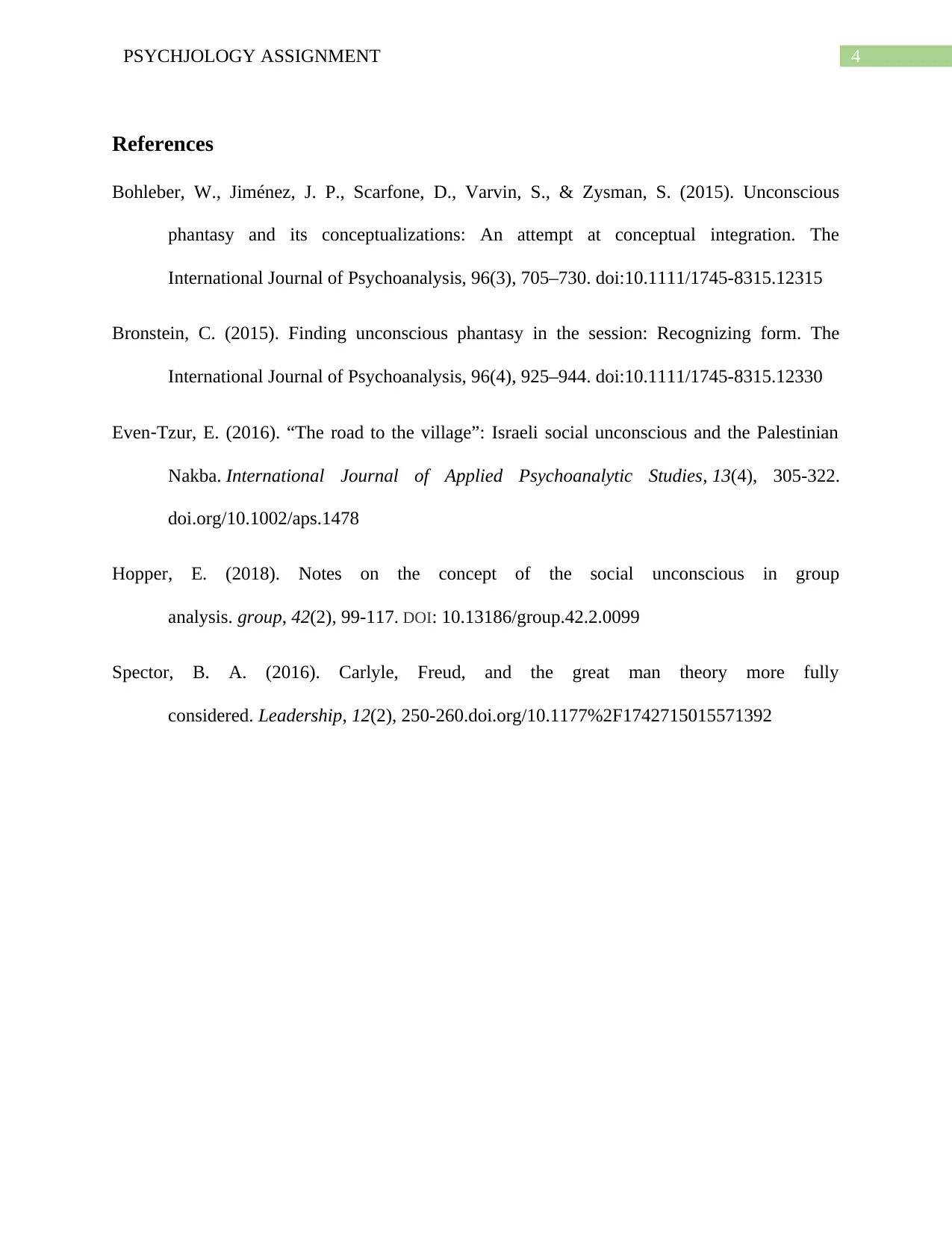
4PSYCHJOLOGY ASSIGNMENT
References
Bohleber, W., Jiménez, J. P., Scarfone, D., Varvin, S., & Zysman, S. (2015). Unconscious
phantasy and its conceptualizations: An attempt at conceptual integration. The
International Journal of Psychoanalysis, 96(3), 705–730. doi:10.1111/1745-8315.12315
Bronstein, C. (2015). Finding unconscious phantasy in the session: Recognizing form. The
International Journal of Psychoanalysis, 96(4), 925–944. doi:10.1111/1745-8315.12330
Even‐Tzur, E. (2016). “The road to the village”: Israeli social unconscious and the Palestinian
Nakba. International Journal of Applied Psychoanalytic Studies, 13(4), 305-322.
doi.org/10.1002/aps.1478
Hopper, E. (2018). Notes on the concept of the social unconscious in group
analysis. group, 42(2), 99-117. DOI: 10.13186/group.42.2.0099
Spector, B. A. (2016). Carlyle, Freud, and the great man theory more fully
considered. Leadership, 12(2), 250-260.doi.org/10.1177%2F1742715015571392
References
Bohleber, W., Jiménez, J. P., Scarfone, D., Varvin, S., & Zysman, S. (2015). Unconscious
phantasy and its conceptualizations: An attempt at conceptual integration. The
International Journal of Psychoanalysis, 96(3), 705–730. doi:10.1111/1745-8315.12315
Bronstein, C. (2015). Finding unconscious phantasy in the session: Recognizing form. The
International Journal of Psychoanalysis, 96(4), 925–944. doi:10.1111/1745-8315.12330
Even‐Tzur, E. (2016). “The road to the village”: Israeli social unconscious and the Palestinian
Nakba. International Journal of Applied Psychoanalytic Studies, 13(4), 305-322.
doi.org/10.1002/aps.1478
Hopper, E. (2018). Notes on the concept of the social unconscious in group
analysis. group, 42(2), 99-117. DOI: 10.13186/group.42.2.0099
Spector, B. A. (2016). Carlyle, Freud, and the great man theory more fully
considered. Leadership, 12(2), 250-260.doi.org/10.1177%2F1742715015571392
1 out of 5
Related Documents
Your All-in-One AI-Powered Toolkit for Academic Success.
+13062052269
info@desklib.com
Available 24*7 on WhatsApp / Email
![[object Object]](/_next/static/media/star-bottom.7253800d.svg)
Unlock your academic potential
© 2024 | Zucol Services PVT LTD | All rights reserved.



